By adding highly accurate images and clinical information of diverse people with Williams-Beuren Syndrome to the atlas, healthcare providers will better recognize and diagnose the rare disease in non-Europeans and deliver critical, early interventions and better medical care. They assessed people with Williams-Beuren Syndrome from African, Asian and Latin American countries, both clinically and by facial analysis technology, developed by Children's National Health System, and published their results in the May 2018 issue of the American Journal of Medical Genetics
Though Williams-Beuren syndrome is a genetic condition, most cases are not inherited. Signs and symptoms include intellectual disability and distinctive facial features, including puffiness around the eyes, a short nose with a broad tip, full cheeks, and a wide mouth with full lips.
The most significant medical problems associated with the syndrome are a narrowing of the large blood vessel that carries blood from the heart to the rest of the body (supravalvular aortic stenosis) and high blood pressure.

Williams-Beuren syndrome affects an estimated 1 in 7,500 to 10,000 people.
Read more about Williams-Beuren Syndrome in Diverse Populations.




